Family and community: intergenerational transmission of religiosity in Russian Orthodox Church
The article examines religious socialization in the families of Russian Orthodox Church parishioners. The analysis is based on the survey of parishioners of 14 churches at the exit after the liturgy, conducted in 2012-2024 (the total sample size is 1393 respondents). Multiple studies show that family is the main primary religious socialization agent. At the same time, the replacement of age cohorts is considered one of the key factors of secularization. There is no consensus in the literature regarding the factors that lead to the gap in the intergenerational transmission of religiosity. The research, conducted by the authors, is aimed at studying the factors influencing the religious socialization of parishioners’ children. Logistic regression models reveal the relationship between attendance at religious services by parents, extended family members and the social environment and the intergenerational transmission of religiosity. The influence of socio-demographic characteristics (age, gender, marital status, education, health, financial situation) on the processes of religious socialization is also analyzed. The results demonstrate an important role of regular church attendance not only within the nuclear family – by the child’s parents, but also by the older generation of the extended family – grandparents, and the broader social environment – the parents’ friends. Involvement of families in the parish community also has a noticeable effect on the successful religious socialization of young generations.
Figures
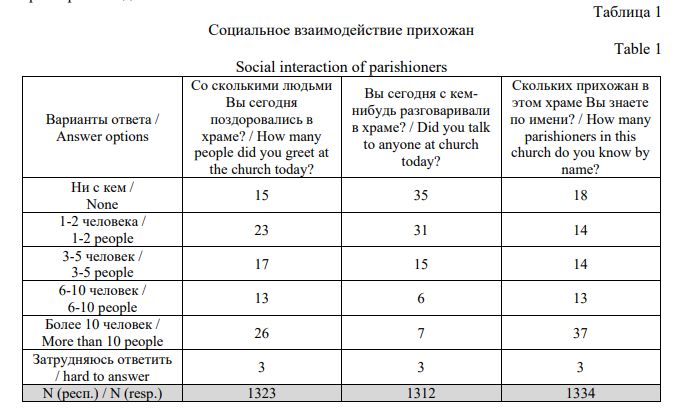
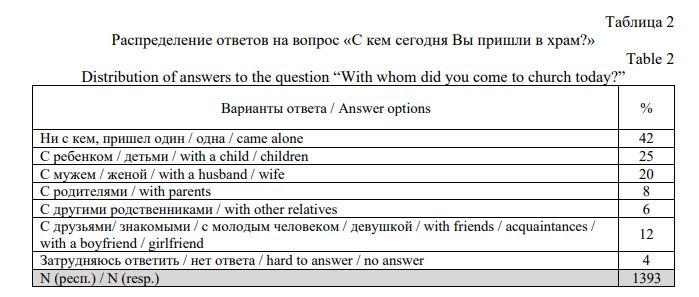
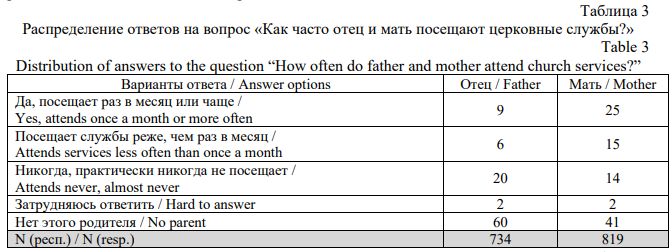
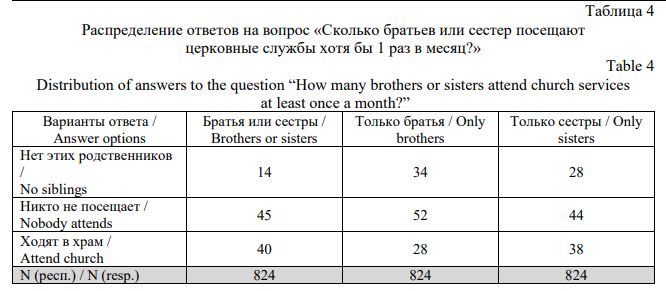
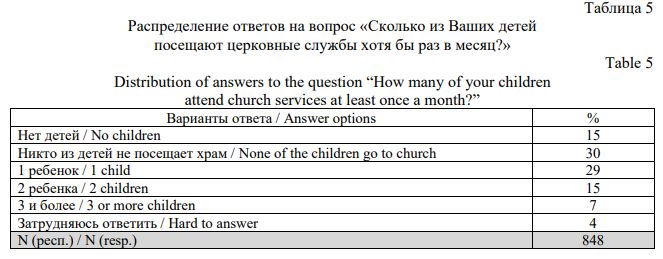

Prutskova, E. V., Baikov, M. D., Pavlov, N. M. (2024), “Family and community: intergenerational transmission of religiosity in Russian Orthodox Church Parishes”, Research Result. Sociology and Management, 10 (4), 50-63. DOI: 10.18413/2408-9338-2024-10-4-0-3


















While nobody left any comments to this publication.
You can be first.
Bezrogov, V. G. (2006), “Between Stalin and Christ: Religious Socialization of Children in Soviet and Post-Soviet Russia (Based on Childhood Recollections)”, Forum for Anthropology and Culture, (4), 130-162. (In Russian)
Guzelbaeva, G. Ya. (2015), “Agents of religious socialization in the post-secular period: Their role in the transformation of the value-normative system”, Kazan Social and Humanitarian Bulletin, 4 (17), 21-26. (In Russian)
Zabaev, I. V. (2011), “Sacred individualism and community in contemporary Russian Orthodoxy”, Prihod i obshhina v sovremennom pravoslavii: kornevaja sistema rossijskoj religioznosti [Parish and community in contemporary Orthodoxy: The root system of Russian religiosity], in Agadjanian, A. and Russele, K. (eds), Ves Mir, Moscow, Russia, 341-354. (In Russian)
Lebedev, S. D. (2005), Dve kul'tury: religija v rossijskom svetskom obrazovanii na rubezhe XX-XXI vekov [Two cultures: Religion in Russian secular education at the turn of the 20th-21st centuries], BelSU Publishing, Belgorod, Russia. (In Russian)
Pavlyutkin, I. V. (2020), “Dynamics of religious commitments of young people in Russia”, Research Result. Sociology and Management, 6 (3), 153-183. (In Russian)
Prutskova, E. V. (2024), Religioznaja socializacija: svjaz' religioznosti s normami i cennostjami [Religious socialization: association of religiosity with norms and values], Izd-vo PSTGU, Moscow, Russia, 256. (In Russian)
Sklyarova, T. V. (2009), “Religious socialization: Problems and directions of research”, Vestnik Pravoslavnogo Sviato-Tikhonovskogo gumanitarnogo universiteta. Seriya IV: Pedagogika. Psihologija, 4 (15), 7-17. (In Russian)
Folieva, T. A. (2012), “Religious socialization: Concepts and problems”, Izvestija Irkutskogo gosudarstvennogo universiteta. Serija «Politologija. Religiovedenie», 2 (9-1), 205-212. (In Russian)
Bainbridge, W. S., Stark, R. (1981), “Friendship, religion, and the occult: A network study”, Review of Religious Research, 22 (4),
313-327.
Bengtson, V. L., Copen, C. E., Putney, N. M. and Silverstein, M. (2009), “A longitudinal study of the intergenerational transmission of religion”, International Sociology, 24 (3), 325-345.
Bengtson, V. L., Putney, N. M. and Harris, S. (2013), Families and faith: How religion is passed down across generations, Oxford University Press, New York, USA.
Cheadle, J. E. and Schwadel, P. (2012), “The ‘friendship dynamics of religion’, or the ‘religious dynamics of friendship’? A social network analysis of adolescents who attend small schools”, Social Science Research, 41 (5), 1198-1212.
Copen, C. E. and Silverstein, M. (2008), “The transmission of religious beliefs across generations: Do grandparents matter?”, Journal of Comparative Family Studies, 39(1), 59-71.
Glass, J., Bengtson, V. L. and Dunham, C. C. (1986), “Attitude similarity in three-generation families: Socialization, status inheritance, or reciprocal influence?”, American Sociological Review, 51 (5), 685-698.
Kelley, J. and De Graaf, N. D. (1997), “National context, parental socialization, and religious belief: Results from 15 nations”, American Sociological Review, 62 (4), 639-659.
Lenski, G. E. (1961), The religious factor: A sociological study of religion's impact on politics, economics, and family life, Doubleday & Co, New York, USA.
Lim, C. and Putnam, R. D. (2010), “Religion, social networks, and life satisfaction”, American Sociological Review, 75 (6), 914-933.
McPherson, M., Smith-Lovin, L. and Cook, J. M. (2001), “Birds of a feather: Homophily in social networks”, Annual Review of Sociology, 27 (1), 415-444.
Müller, T. S., De Graaf, N. D. and Schmidt, P. (2014), “Which societies provide a strong religious socialization context? Explanations beyond the effects of national religiosity”, Journal for the Scientific Study of Religion, 53 (4), 739-759.
Myers, S. M. (1996), “An interactive model of religiosity inheritance: The importance of family context”, American Sociological Review, 61 (5), 858-866.
Norris, P. and Inglehart, R. (2004), Sacred and secular: Religion and politics worldwide, Cambridge University Press, New York, USA.
Petts, R. J. (2015), “Parental religiosity and youth religiosity: Variations by family structure”, Sociology of Religion, 76(1), 95-120.
Prutskova, E. (2021), “Social vs. individual centrality of religiosity: Research in religious and non-religious settings in Russia”, Religions, 12(15), 1-18.
Sherkat, D. E. (2003), “Religious socialization: Sources of influence and influences of agency”, in M. Dillon (ed.), Handbook of the sociology of religion, Cambridge University Press, Cambridge, UK, 151-163.
Silverstein, M. and Bengtson, V. L. (2018), “Linked religious lives across generational time in family lineages: Grandparents as agents of transmission”, in D. F. Alwin, D. H. Felmlee, and D. A. Kreager (eds). Social Networks and the Life Course. Integrating the development of human lives and social relational networks, Springer International Publishing, Cham, Switzerland, 415-429.
Smith, C. and Adamczyk, A. (2021), Handing down the faith: How parents pass their religion on to the next generation, Oxford University Press, Oxford, UK.
Stark, R. and Finke, R. (2000), Acts of faith: Explaining the human side of religion, University of California Press, Berkeley, USA.
Stark, R. and Glock, C. Y. (1968), American piety: The nature of religious commitment, University of California Press, Berkeley, USA.
Stolz, J., Lipps, O., Voas, D. and Antonietti, J.-P. (2024), “Can we explain the generation gap in churchgoing?”, Journal for the Scientific Study of Religion.
Vermeer, P. (2014), Religion and family life: An overview of current research and suggestions for future research”, Religions, 5 (2), 402-421.
Voas, D. and Chaves, M. (2016), “Is the United States a counterexample to the secularization thesis?”, American Journal of Sociology, 121 (5), 1517-1556.
Voas, D. and Storm, I. (2020), “National context, parental socialization, and the varying relationship between religious belief and practice”, Journal for the Scientific Study of Religion, 60 (1), 189-197.
Ysseldyk, R., Haslam, S. A. and Haslam, C. (2013), “Abide with me: Religious group identification among older adults promotes health and well-being by maintaining multiple group memberships”, Aging & Mental Health, 17 (7),
869-879.